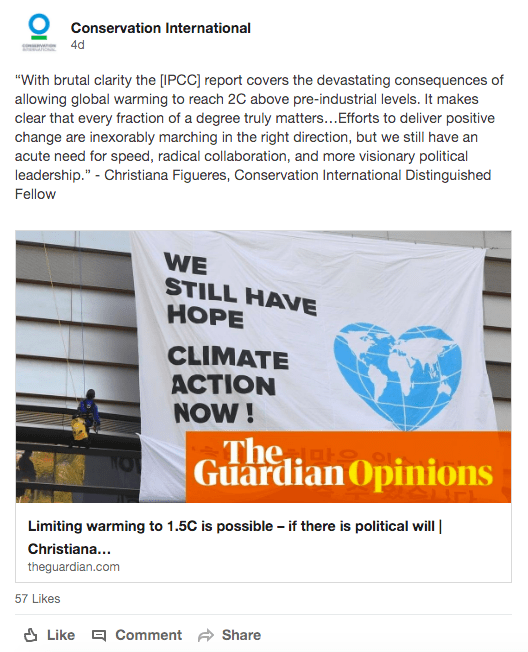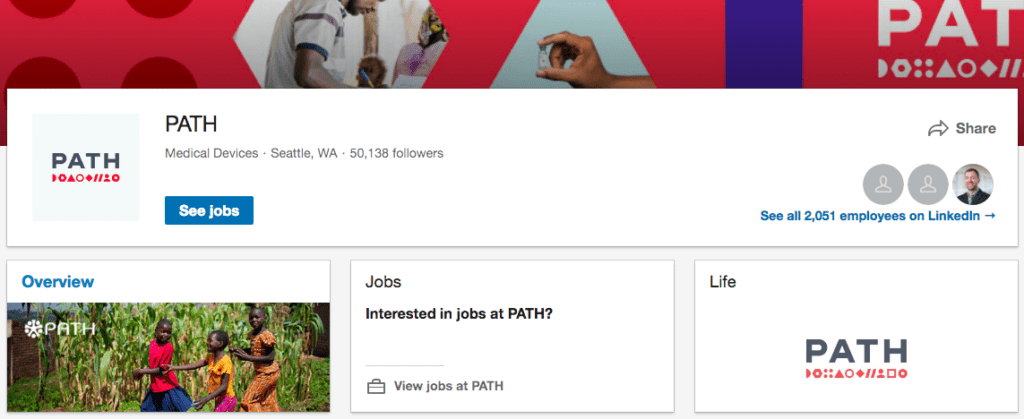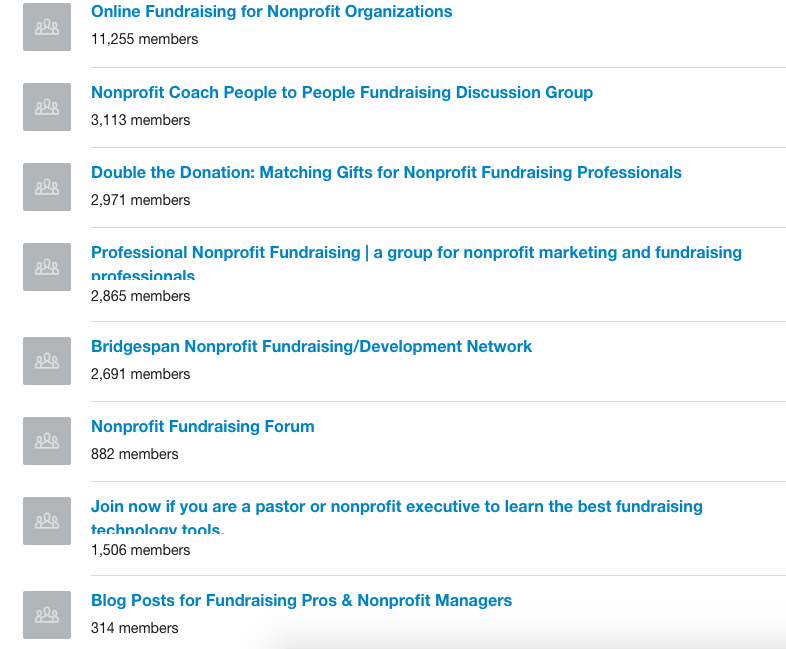How effective is LinkedIn for Nonprofits?
While Twitter is great for sharing quick updates and starting conversations, Instagram for sharing highly visual content, and Facebook for sharing links and integrated videos, LinkedIn is great for content marketing and networking.
LinkedIn is a great resource to use – albeit for different kinds of tasks. Unlike with most other social networks, 90 million LinkedIn users are senior level influencers and 63 million are in decision-making positions. And these individuals don’t come to LinkedIn to find memes or post-wedding photos. They’re looking for great content to advance their personal careers or businesses professionally, or for partnership and sales opportunities.
The audience is really the key differentiator here – it’s what makes LinkedIn stand out compared to other social platforms.
Furthermore, LinkedIn offers tools specifically catered to organizations in a way that no other social network does.
While LinkedIn might initially seem to be useful only for B2B marketing and sales, there is a lot that nonprofits can utilize LinkedIn for. If you’re not sure how to get started on LinkedIn, we’ve compiled a list of ten most effective LinkedIn tips for nonprofits.
*Nonprofit following statistic source: LinkedIn.
10 Powerful LinkedIn Tips for Nonprofits
- Make it Part of the Big Picture
- Make Your Profile Stand Out
- Post Regularly
- Create LinkedIn-Specific Content
- Hire Staff Members
- Recruit Volunteers and Board Members
- Encourage Everyone to Link to Your Page
- Join LinkedIn Groups
- Use LinkedIn Carousel Posts
- Reach Out to Philanthropic or CSR Departments
1. Make it Part of the Big Picture
As with anything else, it’s important to first understand how using LinkedIn will fit in with the big picture of what your nonprofit is trying to achieve. Since nonprofits often operate on shoestring budgets, tight schedules, and overworked staff members – understanding whether and in which way a strategy or a tactic makes sense for your specific nonprofit is vital.
If you’re going to use LinkedIn to achieve specific goals and further your nonprofit’s mission, then make sure that the LinkedIn strategy is an integrated part of your communications strategy.
Define clearly how LinkedIn will contribute to those strategic objectives.
Then, proceed to define your Key Performance Indicators. What are your goals when it comes to LinkedIn? The number of followers, the number of shares, the conversion rates? How will you know your LinkedIn strategy is working?
2. Make Your Profile Stand Out
Before starting with any activity on LinkedIn, make sure your Company Profile is complete.
And prior to creating a new company page for your nonprofit, check whether a page has already been started by one of your employees, ex-employees or supporters.
Note: If you don’t have one, follow these instructions to create a new Company Page.
Fill out as much information about your nonprofit as you can. This will make your organization appear professional and attractive. If your company page is missing a profile picture or a description, jobseekers and donors are less likely to take you seriously as a potential employer or someone trustworthy enough to donate to.
Here’s what to pay attention to:
- Add a ‘profile picture’: Aim for your profile picture to be your nonprofit’s logo (60 x 60 pixels). Logo on a white background will look better.
- Add a ‘cover photo’: Add an attention-grabbing high-resolution cover photo that will accurately represent the look and the feel of your brand. This could be a photograph of your staff members, your volunteers, your beneficiaries, or more.
- Craft a description: Make it concise and well-thought-out – describing your organization’s mission and opportunities to get involved.

3. Post Regularly
A great company page will only accomplish as much for your nonprofit. To capitalize on all that LinkedIn has to offer, post frequently.
You could post about a great number of things: your job openings, new campaigns, testimonials, ‘behind the scenes’, your own content, other organizations’ content, press releases, upcoming events, and more.
By posting regularly, you’re increasing the credibility of your organization, you’re keeping your supporters and followers in the loop, you’re establishing yourself as a thought leader, you’re interacting with others, and you’re staying on top of people’s minds – just to name a few benefits. Your goal should be to maintain a presence without ‘spamming’ your followers’ newsfeeds.
You could also share your fundraising and awareness campaigns on LinkedIn. By posting regular campaign updates and linking to relevant content, you also increase your chances of receiving donations online.
Here are some stats to help you out:
- 74% increase in engagement by including a video in your company update
- 84% increase in engagement by including a link in your company update
- 147% increase in engagement by including an image in your company update

4. Create LinkedIn-Specific Content
Great content is essential to success on LinkedIn (as is to success on any social network – in essence). It’s, however, more visible on LinkedIn where ‘adorkable puppies’ can’t get the same amount of attention as they do on Twitter or Facebook.
When marketing executives were asked where the top places to find relevant, high-quality content was, the results weren’t even close. A massive 91% said LinkedIn, while only 29% said Twitter and 27% said Facebook.
And while it’s great to occasionally share your Instagram or Facebook posts on LinkedIn, if you really want to shine on LinkedIn – you should create content specifically for LinkedIn.
Here’s what Noah Kagan of OkDork.com found about what content works best on LinkedIn:
- Aim for long-form but not too long-form. 1900 word articles get the most shares, so aim for between 1700 – 2100 words.
- Focus on how-to posts and list style posts and steer clear of question posts.
- Keep it to 5, 7, or 9 headings.
- Titles in the 30-50 character range are ideal, with 40 being the best and the target you should aim for.
- Posts with exactly 8 images perform the best.
Track your LinkedIn referring traffic to your website and blog. The click-through rate on LinkedIn is amazing, often higher than that for Twitter or Facebook, provided your content is good.
This helps increase the awareness of your nonprofit.

5. Hire Staff Members
A nonprofit can’t succeed without great people fueling the efforts! And LinkedIn is used by many job seekers looking for their next opportunity.
LinkedIn for Nonprofits allows you to, with big discounts, post your job openings and find highly qualified employees. Those jobs will get automatically promoted to qualified professionals. You can also search the LinkedIn directory and work on building up your brand.
LinkedIn also offers you to talk to nonprofit specialists and can help you every step of the way.
Pro tip: “Life section” gives you the space to talk about your nonprofit’s culture, employee lifestyle, interests, etc. This adds a human touch to your page and is especially helpful if you’re looking to use LinkedIn primarily for hiring and recruiting.

6. Recruit Volunteers and Board Members
LinkedIn is not only filled with students and graduates looking for volunteering opportunities to boost their resumes, but also with professionals looking to volunteer in their spare time and donate their time or skills to a good cause.
Whether you use the “Advanced Search” feature and directly contact potential volunteers or you post a volunteer ‘job posting’ – using LinkedIn to recruit volunteers is quite cost-effective.
It’s also possible to use LinkedIn to recruit board members. Similarly to recruiting volunteers, there are two options for recruiting Board members: posting the opportunity or searching for the right individuals through Advanced Search.

By using the advanced search filters you can find exactly the talent you need for your board position. You can search for skills, past work experience, geography, seniority, and more.
If you decide to post the Board opportunity, make sure you indicate it’s a volunteer role in the title (e.g. Volunteer Board Member).
Here’s a board recruitment success story where a nonprofit directly contacted a professional for the opportunity.
7. Encourage Everyone to Link to Your Page
By everyone, we mean anyone affiliated with your nonprofit. Employees can add your organization to their Experience section, and volunteers and board members can add your organization to their Volunteer Experience & Causes section.
This will increase the chances of others finding your nonprofit since your logo and name will be clearly visible on these personal profiles.
You might also want to consider going through everyone who affiliated themselves with your organization. Under ‘Careers’/’View all employees’, you’ll be able to see a list of everyone on LinkedIn who has listed your organization as their current employer. Remove any ex-employees who have not yet updated their LinkedIn profile, as well as people who are not employees but are claiming to work for you.
This helps maintain accuracy and safeguards your reputation – as you’ll avoid anyone potentially contacting the wrong person or someone sharing something that doesn’t represent your brand.
Pro tip: Encourage your staff members who don’t have a LinkedIn profile up to set one up since that can really further extend your reach. For example, if you post a status update and your employees ‘like’ it, it will also appear in the news feeds of people connected to them.

8. Join LinkedIn Groups
LinkedIn groups are a great way to position your nonprofit organization as a thought leader in your particular nonprofit niche.
Before starting your own group, make sure there isn’t one already created under the same topic – to prevent having dozens of same or similar groups existing. Starting your LinkedIn group is a great way to start a dialogue with your supporters and friends.
In addition to creating your own group, it’s also very beneficial to participate in both local and international groups that relate directly to your nonprofit organization. Group topics can vary from development and fundraising ideas, nonprofit leadership, to marketing and finances for nonprofits.
Post relevant information in your (or other) groups, ask questions and upload pictures. Invite all of your followers to join you there and get involved in the discussions.
Sadly, a lot of LinkedIn groups have gotten a bit noisy. However, there are still some high-value groups that can are a great opportunity for your nonprofit. Find a group that has a tight (usually small and targeted) audience, is approval-only and is well-aligned with your mission.
Pro tip: When posting to any group on LinkedIn, create your subject line as a question as often as possible. Of all posts that convert, roughly 33% include a question mark.

9. Use LinkedIn Carousel Posts
Start sharing valuable content, even if you’re just repurposing past blog posts. Carousel posts are a great way to build your brand and attract donations (especially from major donors).
If presentations and instructional content are an important part of your content strategy, carousel slides can help you share your work with nonprofit professionals all over the world. You can also share your nonprofit’s story or its beneficiaries’ stories with the world with carousel posts that are sure to engage readers.
Many nonprofits come to LinkedIn only to learn and enrich their network. They’d want to know about your experience, fundraising strategy, donor communication plans, and gain knowledge in other important areas. Your posts can be a great way to make valuable connections with these people and grow together.
Similarly, LinkedIn also helps you learn invaluable strategies and tips from other nonprofits in your field by browsing through their presentations. In addition to that, you can access top-notch content from thought leaders in the nonprofit industry without restricting yourself to any learning management system or learning source. You can collaborate with peers, and get feedback on your documents, strategies, and more.
When posting your own presentations, choose your best content and don’t forget to optimize it. Use keyword research to find the most Search Engine Optimized titles, descriptions, and deck content. Be concise and use as much visuals as possible. Your cover page should be compelling and your content solid.
As with almost any other content strategy, don’t forget to drive users to your website. Also, share your presentations on other social media networks.
10. Reach Out to Philanthropic or CSR Departments
In addition to creating a great content marketing strategy that will build trust, establish you as a leader in your field, attract donors, volunteers, staff, and board members – LinkedIn can be used for reaching out to philanthropic or CSR departments.
Many companies and organizations have CSR or philanthropy representatives to whom you can reach out to for building partnerships and obtaining funds for your nonprofit.
LinkedIn is a great place for the corporate world and the nonprofit world to meet and cooperate. Many corporate organizations are looking for nonprofit partners whose missions they want to support.
And if done right, corporate partnerships can revolutionize both your nonprofit’s presence and financial situation – not to mention help you further your mission by enabling you to serve more beneficiaries.
Conclusion
LinkedIn may not be at the forefront of most people’s minds when it comes to social networks and marketing, but it should be. It can be a great tool to increase awareness of your nonprofit – acting as an extension of your brand.
As with any other tool or network, if something works for one nonprofit, it doesn’t have to work for another. So, spend time understanding why you want to invest time in LinkedIn and what will be the best time and resource investment for your nonprofit.
This being said, it’s also true that virtually any nonprofit can use LinkedIn tools in a strategic way to help them achieve their goals. Whether you’re trying to increase your nonprofit visibility, establish credibility and trust, recruit great staff or share your expertise, you can use LinkedIn to achieve it all. Hope our LinkedIn tips for nonprofits help you get there!
Need help with fundraising and donor management? Donorbox is a one-stop shop for nonprofits of all types with affordable and simple-to-use features like Recurring Donations, Crowdfunding, Peer-to-Peer, Event ticketing, Memberships, Donor Management, and more.
Get expert help and premium software at personalized pricing for your nonprofit with Donorbox Premium – we’ll help you take your fundraising to the next level!
Read a plethora of insightful blogs and find free resources on the Nonprofit Blog. Subscribe to our newsletter to receive a curated list of our best resources in your inbox every month.











